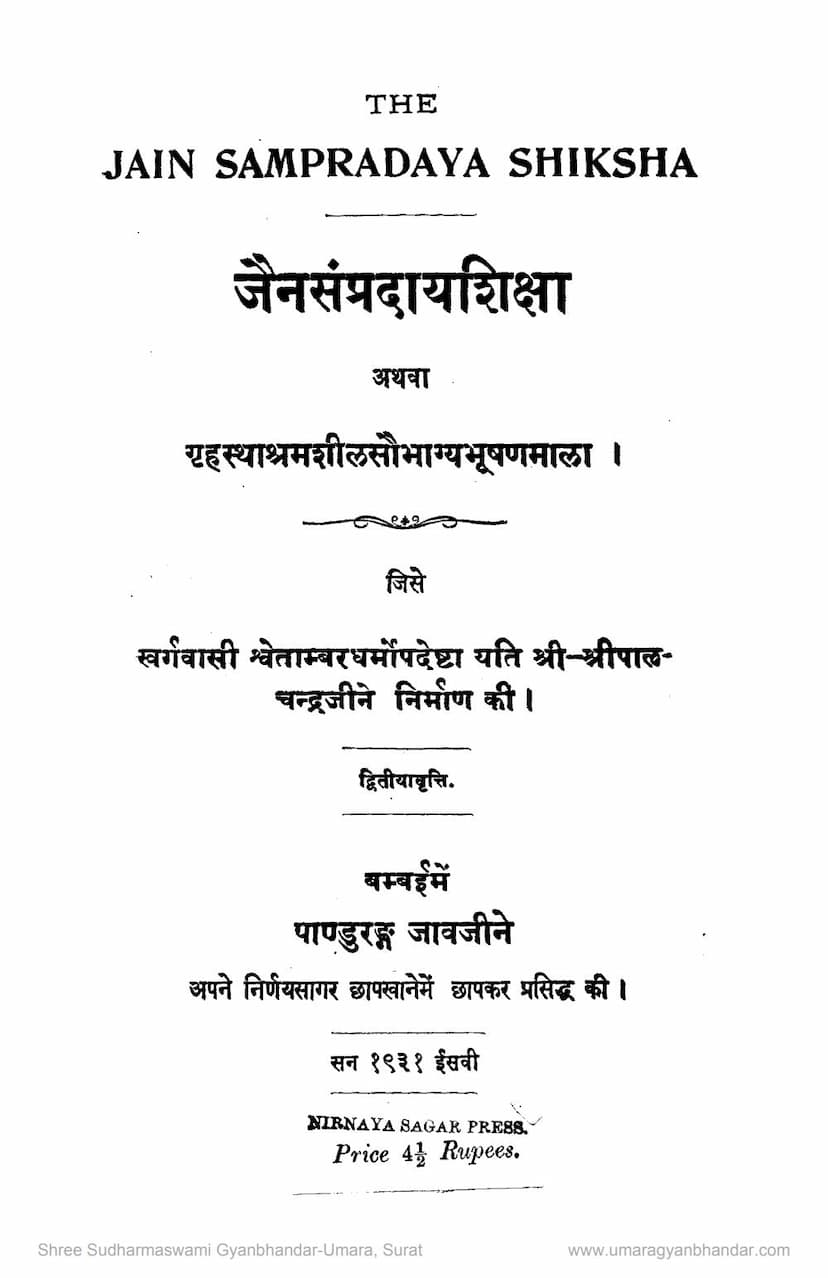Jain Sampraday Shiksha Athva Gruhasthashram Sheelsaubhagya Bhushanmala
Added to library: September 2, 2025

Summary
Based on the provided pages, here's a comprehensive summary of the Jain text "Jain Sampraday Shiksha Athva Gruhasthashram Sheelsaubhagya Bhushanmala" by Shreepalchandra Yati:
Book Title: Jain Sampraday Shiksha Athva Gruhasthashram Sheelsaubhagya Bhushanmala (Jain Community Education or The Garland of Virtuous Fortune in Household Life)
Author: Shreepalchandra Yati
Publisher: Pandurang Jawaji, Nirnaya Sagar Press, Bombay
Year of Publication: 1931 (Second Edition)
Overall Purpose and Scope: This book is presented as a comprehensive guide to education and conduct, particularly for householders, within the Jain tradition. However, the "Bhumika" (Introduction) explicitly states that while the title suggests it's solely for Jains, the topics covered are beneficial for people of all sects, ages, and backgrounds. The text aims to provide practical knowledge on various aspects of life, from personal conduct and health to grammar, ethics, politics, and even astrology.
Key Content Areas:
-
Grammar (Vyakarana) - Chapter 1, Section 1 (Varnsamannay & Vyakarana Vishayak):
- Phonetics and Alphabet: Detailed explanation of vowels and consonants, correct pronunciation, and the formation of combined letters (sanyuktākshar).
- Grammatical Concepts: Covers aspects of Sanskrit grammar like sandhi (vowel and consonant combinations), noun and pronoun classification, adjective usage, verbs, and case factors (kārak).
- Sentence Structure: Discusses the formation of simple and complex sentences, subject-predicate relationships, and the placement of modifiers.
- Vocabulary Building: Includes examples of two, three, and four-letter words, and simple sentences to aid learning.
-
Ethics and Conduct (Sheel) - Chapter 2 (Chanakya Nitishar Dohavali, Subhashit Ratnavali):
- Moral Teachings: This extensive section draws heavily from ethical principles, presented through Doha verses from Chanakya Niti and Subhashit Ratnavali.
- Dharma and Vairagya: Emphasizes the importance of acquiring knowledge that leads to righteousness and detachment.
- Virtues: Highlights virtues like truthfulness, forgiveness, contentment, patience, and the importance of serving elders and gurus.
- Vices: Warns against vices like anger, greed, lust, ego, falsehood, and association with bad company.
- Social Conduct: Provides guidance on behavior in society, relationships with family, friends, and rulers.
- Self-Improvement: Encourages continuous learning and self-discipline.
- Practical Wisdom: Offers practical advice on managing wealth, dealing with adversity, and making wise decisions.
- The Power of Knowledge: Stresses that knowledge is superior to wealth and can overcome even the greatest difficulties.
-
Household Life and Personal Conduct (Gruhasthashram Sheel) - Chapter 3 (Various Topics):
- Women's Duties: Detailed guidelines for women regarding their conduct towards their husbands, emphasizing chastity, devotion, and service. It describes the signs of a virtuous wife and her responsibilities after her husband's passing.
- Menstruation (Rajodarshan): Explains the physiological changes associated with menstruation, the age of onset, typical duration, causes of irregularity, and the necessary duties and conduct for women during this period.
- Pregnancy and Childcare: Offers extensive advice on managing pregnancy, including diet, behavior of pregnant women, fetal movement, signs of full term, and general care for the child after birth. It covers nurturing, feeding, and protecting the infant.
- Health and Hygiene (Vaidyak Vishay): This is a significant part of the book.
- General Health: Discusses the importance of health (arogyata) and clean air (hawa).
- Diet and Nutrition: Provides detailed information on various food groups, their properties (rasa), dietary recommendations (pathyāpathy), and nutritional value. It covers grains, lentils, vegetables, fruits, dairy, and oils.
- Treatment and Remedies: Explains various methods of treating diseases like fever, indigestion, worms, and skin ailments. It touches upon using steam, gargling, enemas, and herbal remedies.
- Seasonal Regimen (Ritucharya): Advises on adapting diet and lifestyle according to different seasons (Vasant, Grishma, Varsha, Sharad, Hemant, Shishir).
- Daily Routine (Dincharya): Outlines recommended daily activities from waking up to sleeping.
-
Specific Sciences and Practices:
- Jyotish (Astrology): Includes sections on calculating sunrise/sunset, understanding auspicious and inauspicious times (tithi, muhurta), and interpreting omens (shakuna vidya).
- Kharoday (Palmistry/Divination): Discusses reading lines on the hand for fortune-telling and interpretation.
- Genealogy and Social Structure: Mentions the origins of various communities like Oswal, Porwal, Khandewal, and Maheshwari, and describes different castes.
Author's Approach: The author, Shreepalchandra Yati, appears to be an experienced individual with broad knowledge across multiple subjects, particularly excelling in medicine. The book is written in a comprehensive and detailed manner, aiming to be a practical guide for daily life. The inclusion of various practical sciences and ethical teachings suggests an intention to promote a well-rounded and virtuous life for householders.
Overall Impression: "Jain Sampraday Shiksha" is a vast and encyclopedic work that aims to educate the householder on a multitude of topics crucial for a righteous, healthy, and prosperous life. It blends religious and ethical teachings with practical knowledge from various secular disciplines like grammar and medicine, reflecting a holistic approach to life within the Jain framework. The detailed table of contents (Vishayanukramanika) highlights the book's ambition to cover almost every conceivable aspect of a householder's life and knowledge.